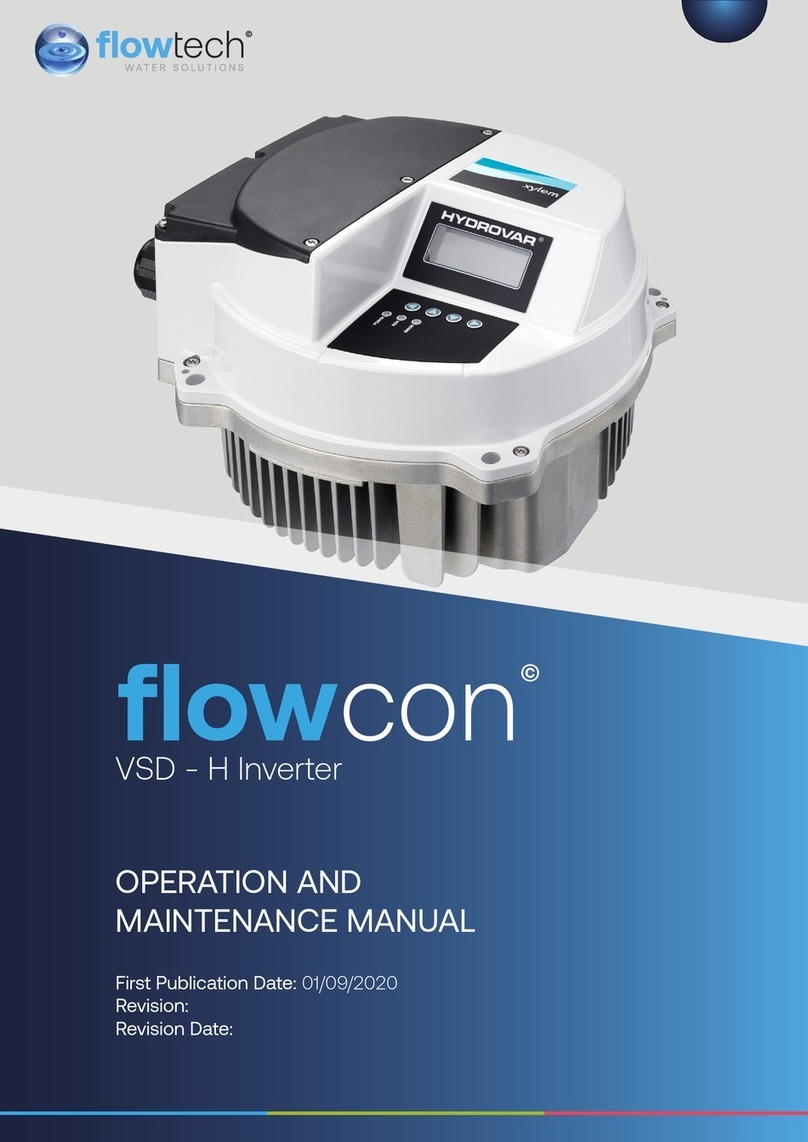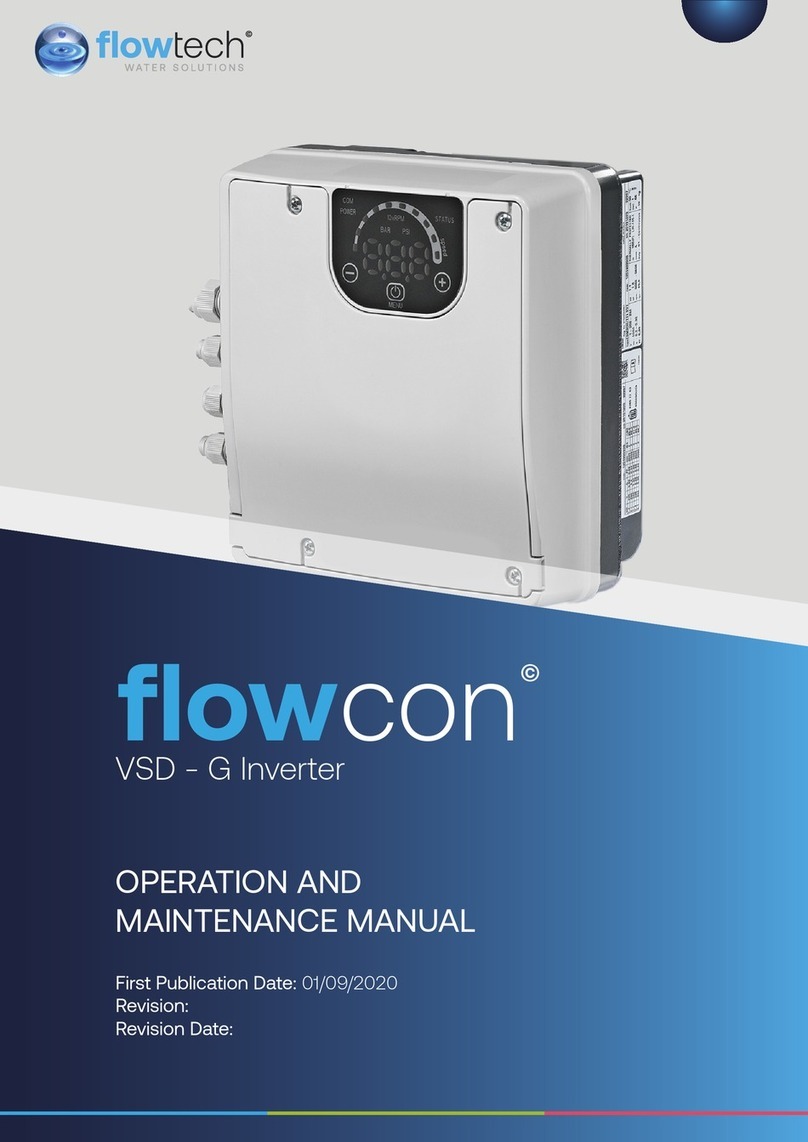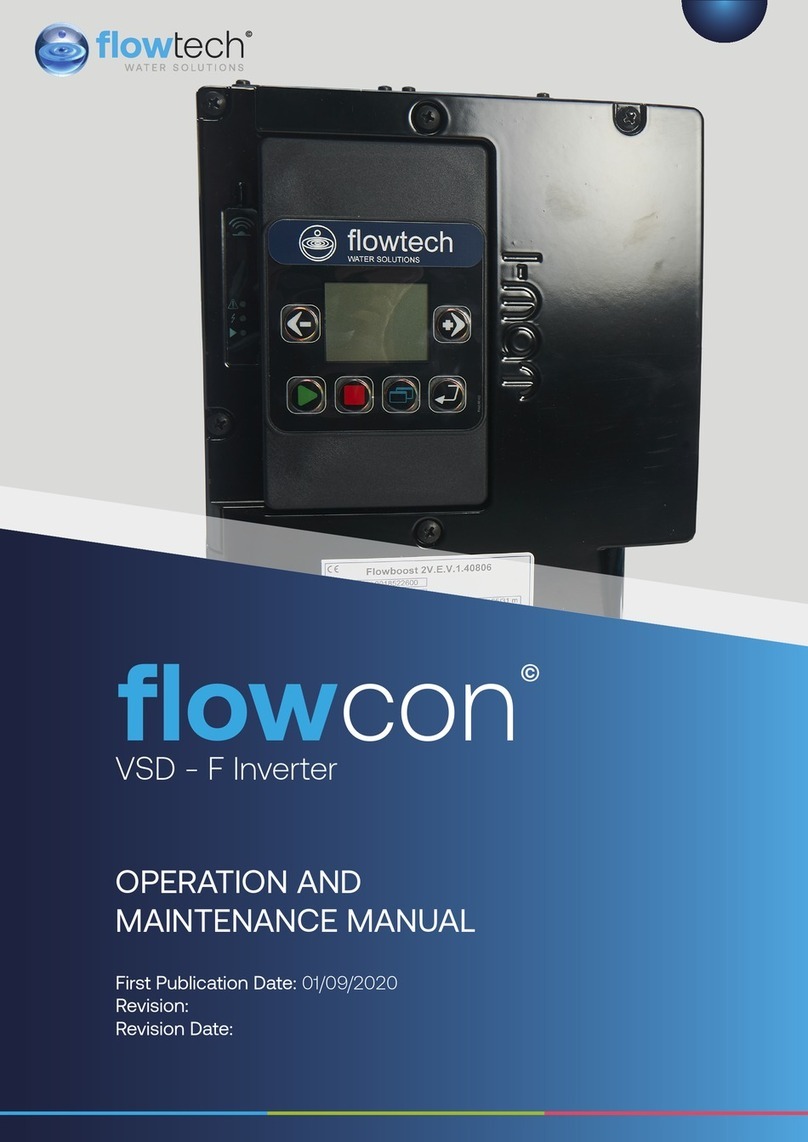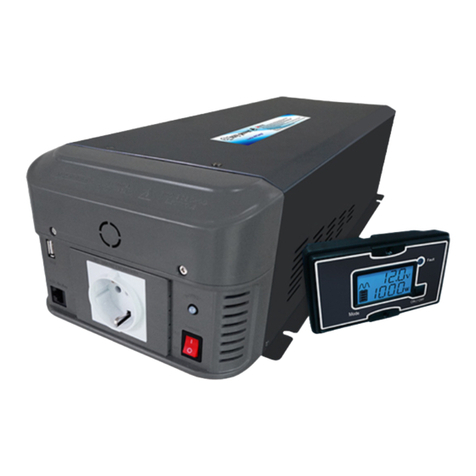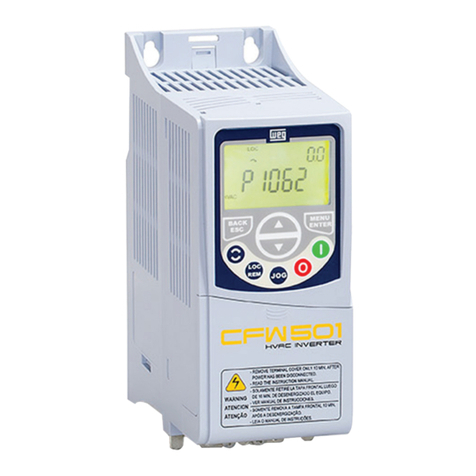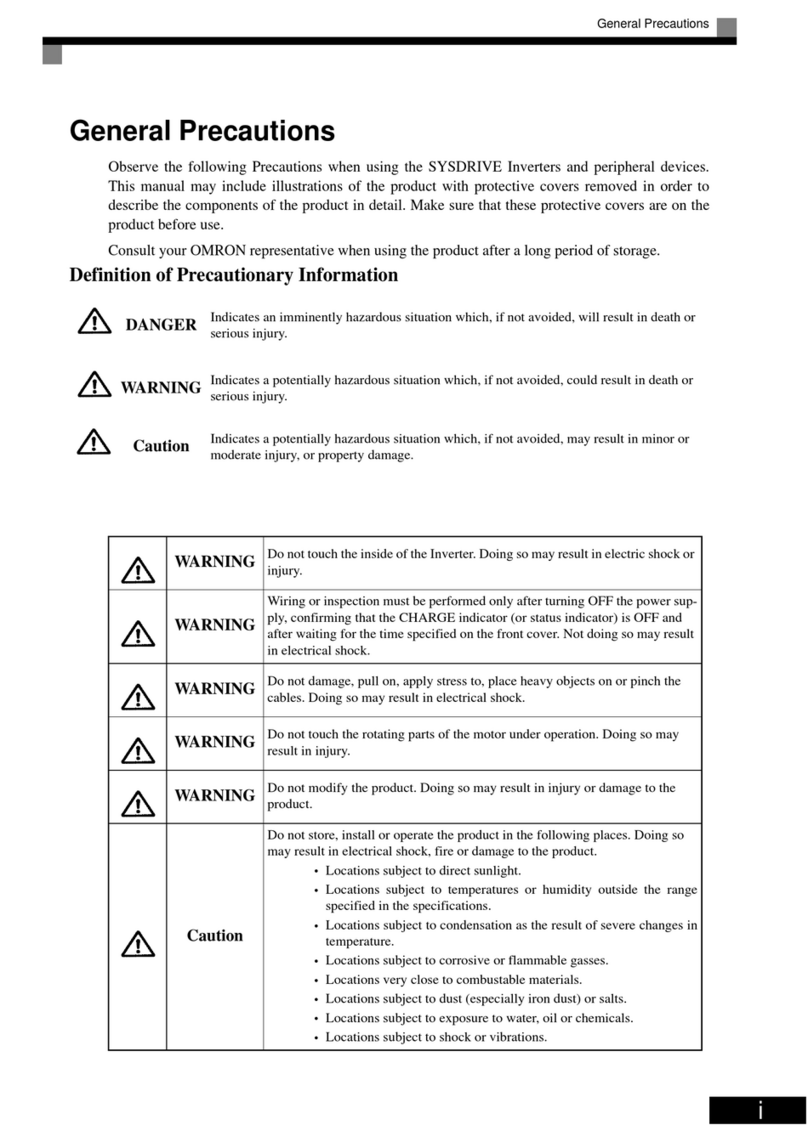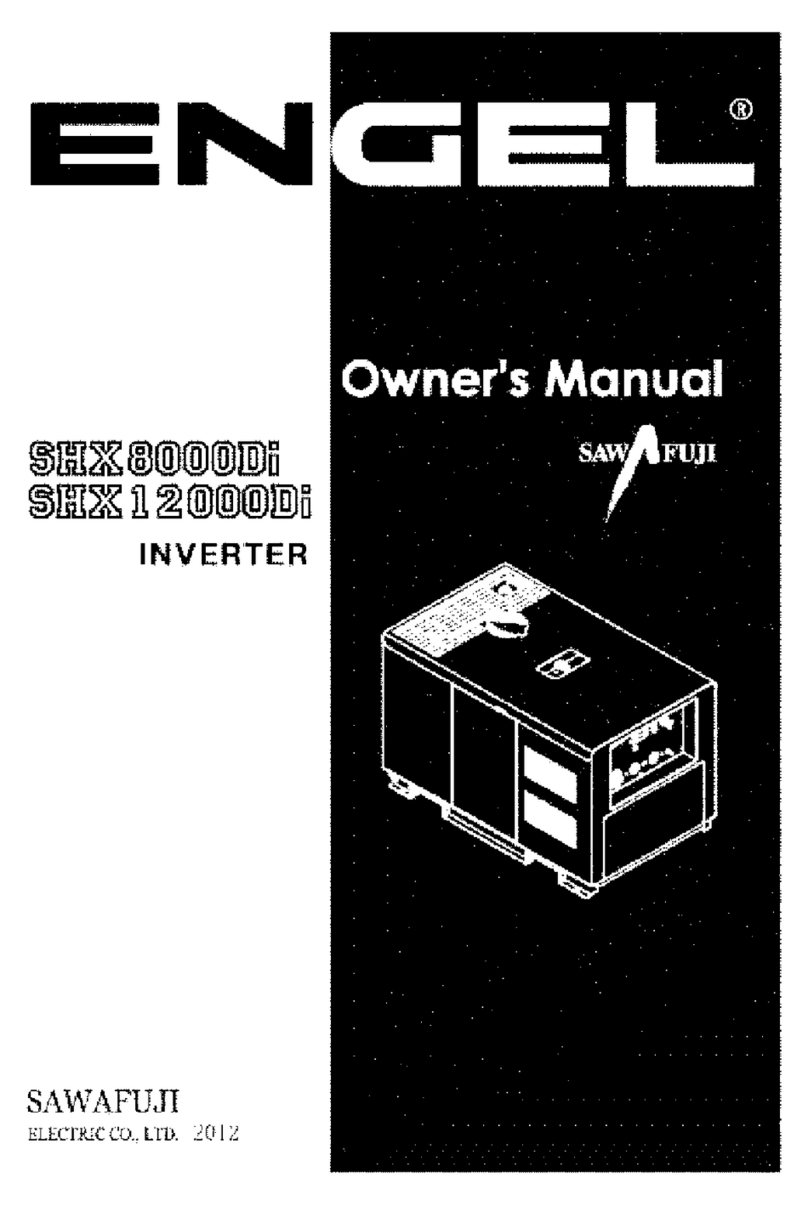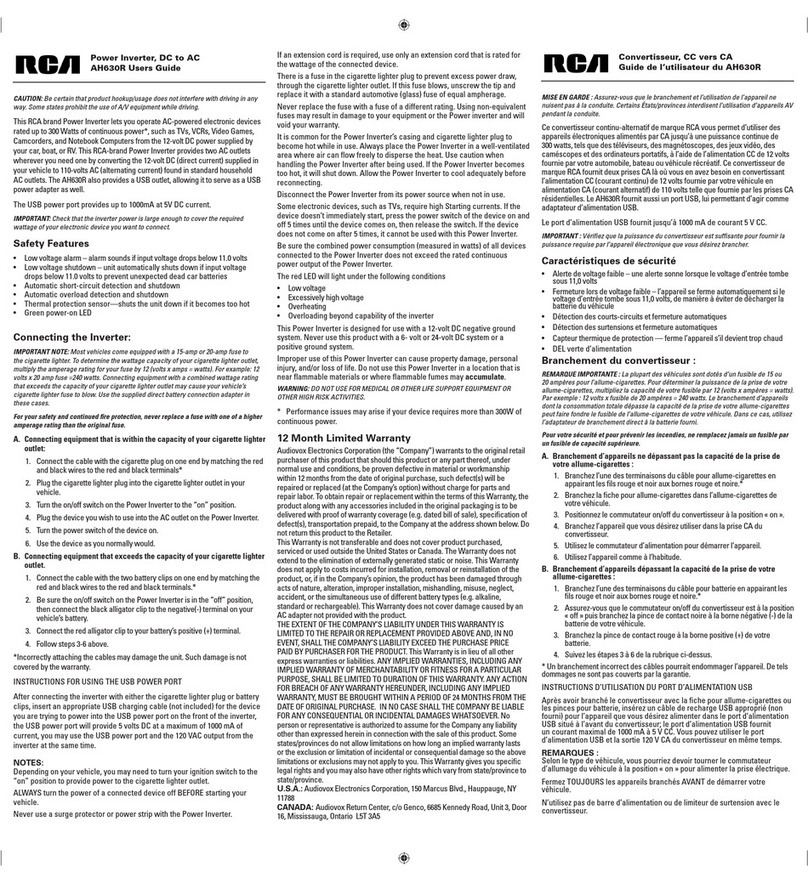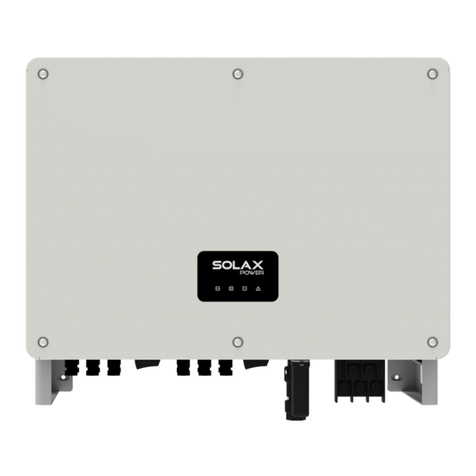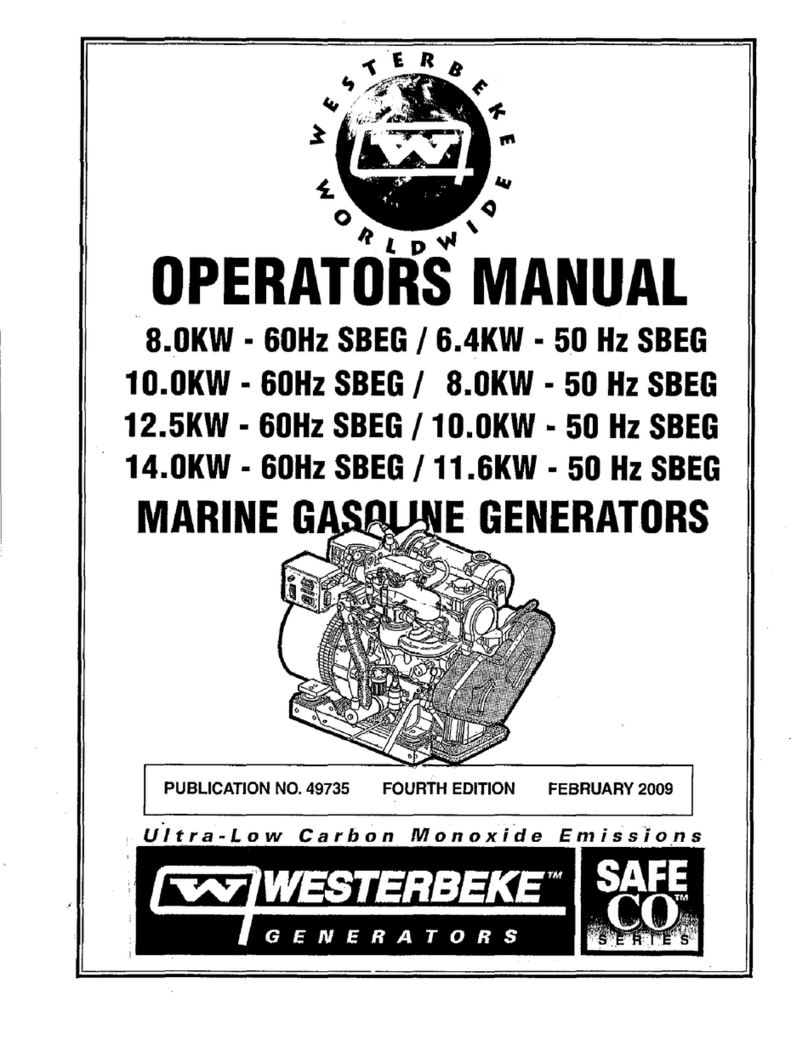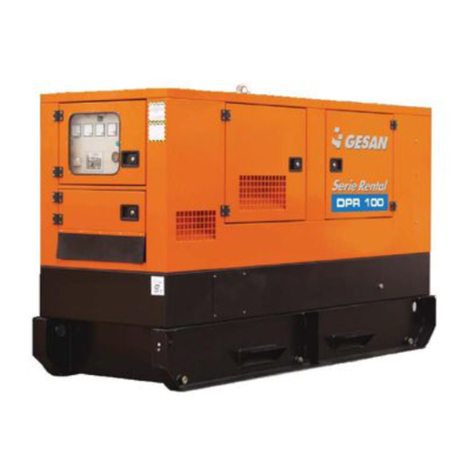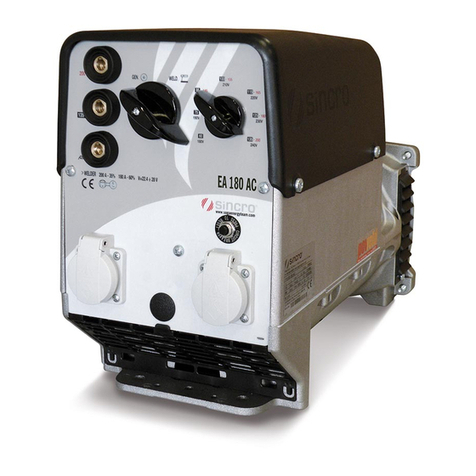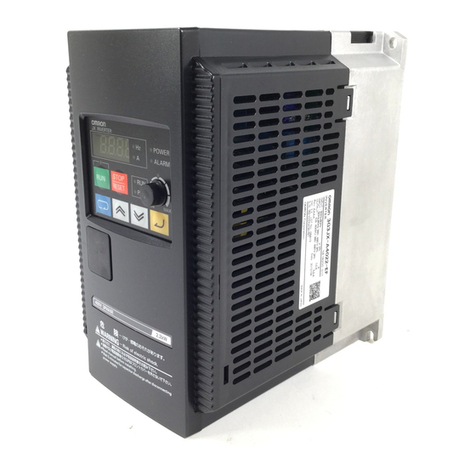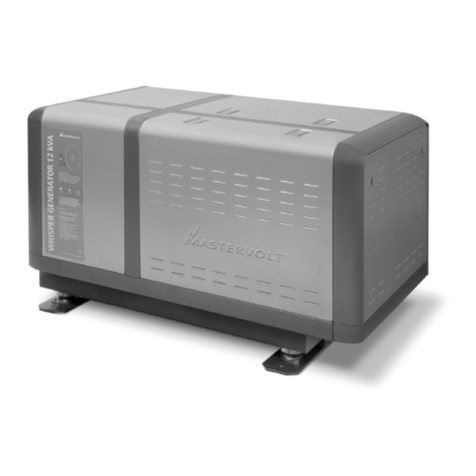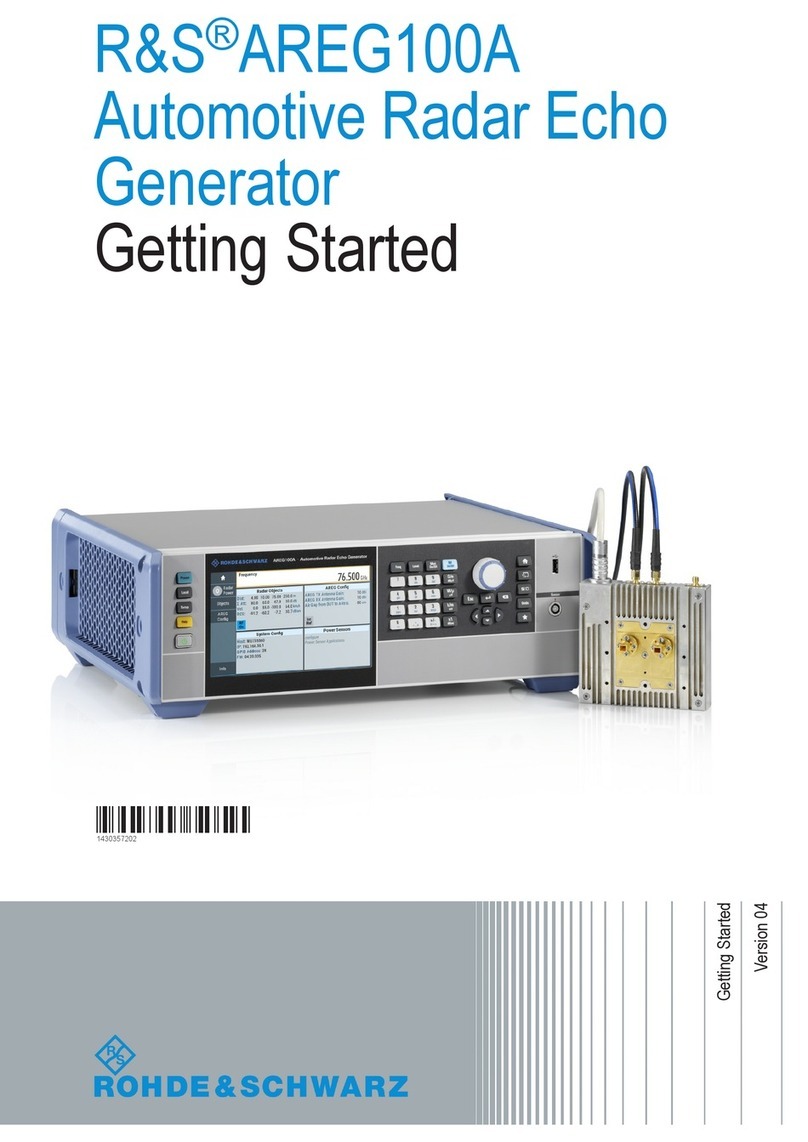FLOWTECH flowcon User manual

1
First Publication Date: 01/09/2020
Revision:
Revision Date:
OPERATION AND
MAINTENANCE MANUAL
VSD - J Inverter
flow
con
©

CONTENTS
OPERATION & MAINTENANCE
2
Description 7
Technical Data 7
Product Identification 7
Size and Weight 7
Storage 7
Installation and assembly 8
Electrical Connections 10
Screen Format 11
Main Screen 12
Operation Mode 12
Start Up Wizard 13
The Setup Menu 15
Warning Management 20
Alarms 21
Maintenance and Repair 22
Warranty 22
Disposal and Environmental Aspects 23

Definitions of Safety Warnings and
Precautions
WARNING!
Indicates a potentially hazardous situation which, if
not avoided, can result in serious injury or death.
CAUTION!
Indicates a potentially hazardous situation which, if
not avoided. Can result in minor to moderate injury, or
serious damage to the product.
General
Information
These instructions are to assist in the installation of the flowcon VSD -J Inverter please follow
them carefully.
If, having read this Operation & Maintenance Manual, there is any doubt about any aspect of
the installation please don't hesitate to contact our technical team.
flowcon VSD - J Inverter
3

Safety
Information
It is essential that correct and safe working practices are adhered to at all times when installing,
operating and/or maintaining any piece of equipment. Always consult safety data sheets, operating
and maintenance manuals, Health & Safety legislation and recommendations and specific
requirements of any equipment manufacturer, site controller, building manager or any other persons
or organisation relating to the procurement, installation, operation and/or maintenance of any piece
of equipment associated or in conjunction with any product provided by flowech Water Solutions.
This document is intended for ALL installers, operators, users and persons carrying out maintenance
of this equipment and must be kept with the equipment, for the life of the equipment and made
available to all persons at all times. Prior to carrying out any work associated with the set it is essential
that the following sheets are read, fully understood and adhered to at all times.
Equipment must only be installed, operated, used, and/or maintained by a competent person. A
competent person is someone who is technically competent and familiar with all safety practices
and all of the hazards involved.
Any damage caused to any equipment by misapplication, mishandling or misuse could lead to risk of
Electrocution, Burns, Fire, Flooding, death or injury to people and/or damage to property dependent
upon the circumstances involved. flowech Water Solutions accepts no responsibility or liability for
any damage, losses, injury, fatalities or consequences of any kind due to misapplication, mishandling
or misuse of any equipment, or as a result of failure to comply with this manual.
Failure to install, operate, use or maintain the equipment in accordance with the information contained
within this document could cause damage to the equipment and any other equipment subsequently
connected to it, invalidating any warranties provided by flowech Water Solutions to the buyer.
4

Safety Warnings &
Precautions
These instructions should be read and clearly understood before working on the system. Please
read this manual carefully and all of the warning signs aached before installing or operating the
equipment keep this manual handy for your reference. This equipment should be installed, adjusted
and serviced by trained and qualified personnel. Failure to observe this precaution could result in
bodily injury.
WARNING! - Install an emergency stop key separately from the isolator. Rotating
shas can be hazardous.
WARNING! - This equipment has a high leakage current and must be permanently
fixed to earth.
WARNING! - Do not aach or remove wiring or connectors when the power is applied.
Do not check signals during operation. When the power is turned on and the running
command is on, the motor will start rotating. The stop key is only eective when the
function is set. If there is a power failure and an operation instruction is given the unit
may start automatically when the power is reinstated.
WARNING! - Make sure that the input voltage is correct. Be sure to install the unit in
a room that is not exposed to direct sunlight and is well ventilated.
Avoid environments which have a high ambient temperature, high humidity or
excessive condensation. Avoid dust. Corrosive gas, explosive gas, inflammable gas,
grinding-fluid mist and salt damage, etc.
WARNING! - Do not connect the power source to any terminals except power
connectors.
WARNING! - Motor control equipment and electronic controllers are connected to
hazardous line voltages. When servicing drives and electronic controllers, you may be
exposed to components at or above the line potential. Extreme care should he taken
to protect against shock. Dangerous voltage may exist aer the power light is o.
Wait more than 5 minutes aer turning o the power supply before performing
maintenance or inspection. Hazard of electric shock. Disconnect incoming power
before working on this unit.
WARNING! - The inverter should be protected separately against ground fault.
Observe the regional regulations for electrical installation!
flowcon VSD - J Inverter
5

CAUTION! - It is strongly recommended that all electrical equipment conforms
to National Electrical Codes and local regulations. Only qualified personnel should
perform installation, alignment and maintenance. The manufacturer reserves the right
to alter the technical data in order to make improvements or update information.
CAUTION! - Failure to observe these rules will render the guarantee invalid. The same
applies to repair jobs and/or replacement. Your legal rights are not aected.
CAUTION! - The manufacturer declines all responsibility in the event of damage or
injury caused as a result of tampering with the equipment.
CAUTION! - Do not switch on/o power supply to run/stop the motor/system! Start
the unit only by using run buon or external run command.
Customer / Contractor
RESPONSIBILITIES
It is the responsibility of the customer and/or the contractor:
• To ensure that anyone working on the equipment is wearing all necessary protective gear
and/or clothing.
• Is aware of appropriate health & safety warnings.
• Has read the information in this section of the manual.
6

flowcon VSD - J Inverter
7
Description
The following product is an electronic device for the control and protection of pump systems according to the
frequency of the pump’s power supply. The inverter can be connected to any pump to manage its operation
and maintain a constant pressure.In this way, the pump or pump system is only activated when needed,
avoiding unnecessary waste of energy and prolonging its useful life.
Technical Data
MT 2200 TT 4000
Power Supply Voltage (V) 220-240 V Single
Phase
400 V Three
Phase
Motor Voltage (V) 230 V Three Phase 400 V Three
Phase
Working Frequency (Hz) 50/60 Hz 50/60 Hz
Maximum current at inverter output (A) 11 A 11 A
Maximum current at inverter output (A) 20 A 12 A
Protecon Rang IP 55* IP 55*
Protecon Degree 2 2
Type of Acon 2B 2B
Operaon S1 S1
Grounding Systems Distribuon IT, TN-C, TN-S, TT IT, TN-C, TN-S, TT
*The auxiliary fan supplied for wall mounting has a protection rating of IP54
Limits of Use:
- Minimum ambient temperature: -10oC
- Maximum ambient temperature: +40oC
- Variation in the supply voltage: +/- 10%
- Humidity range: 5% to 95% without condensation and vapour.
- Maximum altitude: 2.000 meters
Product Identification
Size and Weight
Dimensions Volume Weight
MT 2200 330 x 230 x 170 0,013m33.5 Kg
TT 4000 330 x 230 x 170 0,013m33.5 Kg
Storage
The product must be stored in a covered and dry place, away from sources of heat and protected from dirt
and vibrations, moisture, heat sources and possible mechanical damage. Do not place heavy objects on top
of the packaging.

8
Installation and assembly
Before installing the frequency inverter, carefully read the whole of this manual and consult the safety
regulations in force in the country in which it will be used. The installation must be carried out by a qualified
technician.
a. Installation of the inverter:
• It must be installed in a well-ventilated area, protected from damp and direct exposure to the sun
and rain.
• Before making the electrical connections, ensure the cable used to provide power to the inverter
is not live.
• Carefully verify the electrical data indicated in the specifications plate of the inverter before con-
necting the electric current.
• The electric power cables to the inverter, and from the inverter to the pump, must be of the cor-
rect size for the nominal consumption of the motor and the length of cable required, according
to the regulations in force in the country in question. A table with the maximum recommended
lengths according to the cross-section of the electrical cable can be found below.
Secon of inverter input (mm2)Secon of inverter output (mm2)
1.5 2.5 41.5 2.5 4
Maximum distance (metres) Maximum distance (metres)
MT 2200 8 19 35 12 28 51
TT 4000 46 76 120 49 81 134
Each interface cable length should be shorter than 3 meters.
Use the appropriate cable glands to aach the cable.
Also ensure that the grid has electrical protection; a high-sensitivity dierential switch (30mA, class A for
domestic applications, class B for industrial applications) is particularly recommended.
The type B should be installed for all the residual current-operated protective or monitoring from an inverter up
to the supply voltage.
In addition to the dierential switch, it is advisable to install magneto thermal protection and a voltage
disconnect switch to control the power supply to each inverter individually.
Ground must be connected properly. If the ground is not connected, the electric show or fire might be
happened.
b. Installation of pressure units with an inverter:
The multiple pump unit must always consist of pumps that are the same and that, therefore, have the
same power and hydraulic performance. Failure to comply with this point can cause the pump system to
malfunction.
For the inverter to work, it is essential to use a pressure transducer (4-20 mA).
The location of the pressure transducer must always be as close as possible to the pump unit, as close
as possible to the membrane expander, and always aer the general retention valve of the pump unit it
is essential to install a general cut-o valve for the pump unit, aer the physical location of the pressure
transducer.
If there is more than one pressure transducer in a multiple pump unit (more than one inverter with a pressure
transducer connected), the network of interconnected inverters will decide automatically, and with prior
reliability tests of the readings of the existing transducers, which is the transducer that will be used as the
general pressure sensor for the whole group.

flowcon VSD - J Inverter
9
If the designated transducer functions erroneously, the set of inverters will decide to automatically change the
principal transducer for another that provides more precise readings. The rest of the transducers will remain
on standby ready to be used when required
c. Installation on a motor:
Replace the cover of the motor terminal box with the motor support adapter (parts 5 and 11a) provided.
Break the three holes of the metal radiator of the power circuit (part 4) with a screwdriver. The three holes are
visible on the inside of the radiator. Screw the metal radiator to the motor support adapter with the help of the
2 screws provided for this purpose (parts 9 and 11b).
Tighten the appropriate cable glands to guarantee the declared protection rating (part 10).
Carry out the electrical connections between the power circuit and the moto using the electric cables
supplied (item 6).
Connect the power circuit to the cover + control circuit (part 1) using the flat cable.
Screw the assembly together (part 13).
d. Installation on a wall bracket:
WARNING: For the installation on the wall, point 2 of the previous section regarding installation on a motor
should not be carried out, since the three holes in the metal radiator would not ensure the adequate
protection rating.
Fix the wall bracket to the wall through the three rear holes of the wall bracket (part 7).
Place the fan at the base of the wall bracket, ensuring upwards airflow (part 8).
Place the inverter assembly inside the wall bracket, ensuring that the 2 ends of the metal radiator are inside
the wall bracket.
Fix the inverter to the wall bracket using the two side screws drilled into the metal radiator (part 14).

10
Electrical Connections
It is necessary to install a magnetic core (A).
You will find it in the accessories box. It must be fied to: (MT) the power cable of the frequency inverter,
as close as possible to the cable gland. (TT) the cable between frequency inverter and motor, as close as
possible to the frequency inverter connector, until a click (B) is heard.
a. Power Connections
Model Power Supply Motor
MT 2200 Single phase 230 V Three-phase 230 Vac (DELTA connection*)
TT 4000 Three-phase 400 V Three-phase 400 Vac (STAR connection*)
*For 230/400 V motors

flowcon VSD - J Inverter
11
b. Signal connections
Signal Descripon
Outputs relay 1
and 2
Outputs that act accordingly to how the parameters 5.14 and 5.15 respectively have been
programmed. These outputs are potential free and have a maximum load of 5 amperes
at 230 Vac.
Fan When wall-mounted, as there is no cooling from the motor’s own fan, the ventilation
system of the wall mounting shall be used for this cooling. This output is 24 Vdc and it is
activated whenever the inverter is giving a voltage output; its maximum load is 9 W.
Digital Inputs 1
and 2
You can connect any potential free contact that will perform the functions programmed
in parameters 5.12 and 5.13 respectively to these inputs.
NOTE: Do not apply voltage to these inputs!
Transducer Connection of the pressure transducer (always 4-20 mA), maintaining the correct polarity
shown in the connections diagram of the transducer itself.
RS485
Communication
The
various inverters that you wish to communicate should be interconnected at these
terminals (maximum 8). They are connected point to point. The “1” terminals must be
connected together in the same way as the “2” terminals
Screen Format

12
Main Screen
Current rotation frequency Instant consumption Nominal consumption Stop frequency
H z 4 8 . 9 ( 4 8 . 8 )
A M P 0 8 . 3 ( 0 8 . 9 )
B a r 0 5 . 5 ( 0 5 . 5 )
1 4 : 5 7 M e n u
Current Time Current Pressure Working Pressure Access to the menu
Operation Mode
The operation mode of the inverter will continuously seek to minimise the electricity demand, at the same
time guaranteeing minimum wear to the pumps.
a. Single pump unit:
By the direct reading of the pressure transducer, the variable speed drive is responsible for managing
the rotation speed of the electric motor of the pump, guaranteeing the mains pressure remains fixed
and unaltered, regardless of the instantaneous demand for flow required. When the demand for flow is
at its greatest, the pressure of the water network decreases. In this point the pressure transducer, which
continuously informs the inverter of the current pressure, causes the inverter to make the electric motor
rotate more quickly, guaranteeing the established working pressure. In contrast, when the demand or flow
decreases, the inverter makes the electric moto rotate more slowly so the pressure of the water network
remains unaected.
b. Unit with several pumps (Multi inverter):
When there is a network of two or more inverters connected together, the system decides in an alternate and
orderly manner which pump must start up first, when there is demand for flow.
Once this pump starts to rotate, if it stops because there is no more demand for flow, the system will start up
a dierent pump the next time it starts up, rotating all the pumps that comprise the network of inverters so
that all the pumps in the inverter network are stated up the same number of times.
If a pump is running and reached maximum rotational speed and the network pressure does not reach the
established working pressure, the system will decide whether to start up one more pump, to support the first
one or however many are running at that time.
At that time the network of inverters will calculate the rotational speed of the motors that guarantee the
minimum electricity demand at the same time as maintaining the working pressure.
Similarly and with this same premise of maximum energy savings the system will continually calculate when it
can disconnect each pump that is running at any time.

flowcon VSD - J Inverter
13
Start Up Wizard
The first time you connect the voltage to your unit, a start up wizard will run in which you can configure the
basic parameters to be able to start up the pump unit. This wizard only runs on one of the units regardless of
the total that are connected.
While using this wizard the red LED will blink indicating that this process is under way.
E s p a n o L
E n g l i s h
F r a n c a i s
O K
T H E S T A R T - U P
W I Z A R D I S
A B O U T T O S T A R T
O K
S T A R T - U P W I Z A R D
N O . O F P U M P S
X
R e p e a t O K
S T A R T - U P W I Z A R D
R O T A T I O N T E S T
X
S T A R T
R O T A T I O N C O R R E C T
Y E S
N O
R e a p e a t O K
C O N F I G U R E
D A T E A N D T I M E
1 0 / 0 2 / 1 6 - 1 1 : 0 9
W e d n e s d a y N e x t
C O N F I G U R E
D A T E A N D T I M E
1 0 / 0 2 / 1 6 - 1 1 : 0 9
W e d n e s d a y O K
The system automacally indicates the number of
inverters (x) that are connected to your network. It is an
indicave parameter and cannot be modied.
With F1 you can repeat the automac search if the value
shown “x” is dierent from the real value.
If you perform various searches and the value sll does
not coincide, there is probably a connecon error in the
network of inverters.
Before Carrying out this point, you must use the graphic
sign on the pump motor to check its rotaon direcon,
as it may be clockwise or an-clockwise depending on
the pump model.
In this point you can see how the motor makes a
sequence of slow turns so you can easily see whether the
rotaon direcon is correct. It performs 6 rotaon tests
and stops the motor.
F1 restarts the rotaon test.
If the rotaon direcon is not correct, select NO with the
arrows and restart the test by pressing F1 to verify that
the rotaon direcon has been changed successfully.
Once you have veried that the rotaon direcon is
correct, select YES and then accept it with F2.
Use the arrow keys to increase or decrease the value that
is blinking and use F2 to change to the next value. The
sequence of values is:
DAY – Month – Year – Hour – Minutes
The lower le part of the display indicates the day of
the week calculated automacally according to the date
entered.
When you modify the last value (minutes) you can accept
the changes by pressing F2.
Note: At any point of the date you can go back to the
previous value by pressing F1.
In this point you must enter the nominal consumpon
of the motor, increasing of decrease the value using the
arrow keys and validang with F2.
Note: the nominal consumpon is indicated on the
specicaons plate of the motor. You must choose the
correct value, for example if you connect an inverter
MT2200 select the value 230V and for the TT4000 select
the value 400V.

14
S T A R T - U P W I Z A R D
M O T O R C U R R E N T
5 . 0 A m p
O K
S T A R T - U P W I Z A R D
T R A N S D U C E R S C A L E
1 0 . 0 B a r
O K
S T A R T - U P W I Z A R D
WO R K I N G P R E S S U R E
4 . 0 B A R
O K
S T O P F R E Q . S E A R C H
P R E S S O K
T O S T A R T
O K
1 - O P E N P R O P U L S I O N
2 - P R E S S O K
3 - W A I T 1 0 s e c
O K
3 - WA I T 7 s e c
5 0 . 0 H z 2 . 4 B a r
Automac
C L O S E P R O P U L S I O N
S L O WL Y A N D
P R E S S O K
5 0 . 0 H z O K
S T O P F R E Q U E N C Y
4 3 . 5 H Z
R e a p e a t O K
T H E W I Z A R D H A S
F I N I S H E D
S U C C E S F U L L Y
NOTE: All the data entered or calculated in the wizard can be modified later through the unit menu.
Use the arrow keys to enter the maximum
range for the pressure of the transducer
connected.
This value is indicated on the specicaons
plate of the pressure transducer and must
always be between 4 and 20 mA.
Validate this with F2.
Use the arrow keys to enter the pressure at
which you want the unit to work.
You must take great care that this value is
always within the working curve of the pump
and always try to avoid the extremes of the
curve in other words with ows near 0 or very
low pressures.
Validate this with F2.
Once you have reached this point the inverter
will program itself to know when it no longer
has any demand for ow and should stop.
To do this it will ask for help to understand
the features of the installaon to which it is
connected.
We must follow the instrucons indicated on
the screen exactly.
Open propulsion: You must open the
general propulsion of the system to cause
consumpon of ow.
Click on OK: Once the propulsion is fully open,
accept it using F2.
Once you have pressed F2 the pump will start
up.
At this point you must close the propulsion
gradually (using a minimum of 5-7 sec) unl
the ow consumpon is zero. At this moment
the pressure of the installaon must be the
pressure entered previously into the wizard.
Once the propulsion has been closed and
the working pressure established, press F2 to
accept.
The opon “Accept” will only appear if we
reach the working pressure that we have
indicated. In the case of not reaching the set
pressure without water consumpon, the
“accept” opon will not be displayed.
Wait 10 seconds: it takes a ten-second
countdown aer which the next step to take
will be indidcated.
The countdown will not start if the indicated
pressure is above what we have set in the set
pressure. If once the countdown starts the
pressure increases too much, the counter will
show the 10 seconds again unl the pressure
does not decrease.
The stop frequency calculated is indicated, this
is: for the working pressure indicated, when
the pump drops below this frequency it does
not generate any ow so the motor then stops.
Press F1 to return to the inial stop frequency
search screen. Accept by pressing F2.
It shows a text for a few seconds indicang
that the wizard has nished successfully before
showing the main screen.

flowcon VSD - J Inverter
15
Start Up Wizard in Systems with Two or More Pumps
In systems with two or more pumps, the start up wizard will run in the unit that has the transducer connected, and only
that unit will indicate the first screen of the wizard. If there is more than one pump with a transducer connected, the
system will decide automatically which unit of those that have a transducer will be used to run the wizard. Once the
wizard has finished in the unit selected, the other units on the network will be fully programmed with the same data.
It will only remain to run the rotation test of its wizard and the slave pumps will have the red warning light on and an
indication on the screen of the rotation direction test. Once their rotation tests have been performed, it will go directly to
the main screen and the assembly will be fully programmed.
The Setup Menu
1. Parameter 2. Display 3.0 Log 4. Manual 5. Advanced Parameters 6. Fine Tuning
1.1 Working Pressure 2.01 Module Temperature 5.01 Language 6.01 Proportional Constant
1.2 Motor Current 2.02 Analogue Signal 5.02 Units of Pressure 6.02 Integral Constant
1.3 Rotation Direction 2.03 Voltage Hours 5.03 Maximum Number of Pumps On 6.03 Switching Frequency
1.4 Stop Frequency 2.04 Hours Worked 5.04 Transducer Full-Scale Value 6.04 Stop Switching Range
1.5 Start-Up Dierential 2.05 Start-Up Number 5.05 Working Pressure 2 6.05 Stop Switching Speed
2.06 Digital Input 1 5.06 Principal Stop Delay 6.09 Alarms Reset
2.07 Digital Input 2 5.07 Minimum Working Frequency 6.10 Reset Number of Start Ups
2.08 Relay 1 Output 5.08 Maximum Working Frequency
2.09 Relay Output 2 5.09 Auxiliary Operating Frequency
2.10 Soware Version 5.10 Minimum Operating Frequency
2.11 Cons. Power of Pump 5.11 Minimum Auxiliary Stop Delay
2.12 Cons. Power of Network 5.12 Digital Input 1
5.13 Digital Input 2
5.14 Relay Output 1
5.15 Relay Output 2
5.16 Schedule Program 1
5.17 Program Start Time 1
5.18 Program Stop Time 1
5.19 Schedule Program 2
5.20 Program Start Time 2
5.21 Program Stop Time 2
5.22 Low Water Level Alarm Active
5.23 Low Water Level Alarm Delay
5.24 Burst Pipe Alarm
5.25 Voltage Alarm Active
5.26 Parameter Lock
5.27 Set Date and Time
5.28 Stop Adjustment Input Wizard
5.29 Factory Seings

16
1. Parameters
Parameter Descripon Units Programming Notes
Default Min. Max.
1.1 Working
Pressure
Bar Wizard 0.5 FS Pressure you wish to maintain in the
system.
1.2 Motor Current Amp Wizard 0.1 11 Current of the motor in amperes. Taking
into account whether your motor is wired
as three phase 230V or three phase 400V.
1.3 Rotation
Direction
0 1 You can change the rotation direction of
the motor by modifying this parameter
from 0 to 1 or vice versa.
1.4 Stop
Frequency
Hz Wizard 0.1 99.9 The system will stop when the inverter
has been working for a certain time (see
parameter 5.06) below this frequency.
1.5 Start-Up
Dierential
Bar 0.5 0.3 3 This is the dierential that enables you to
reduce the pressure to start the pump
using the value entered in parameter 1.1.
Wizard: This parameter is the one entered or calculated in the start-up wizard.
FS: Full scale value of the transducer (entered in the start-up wizard).
2. Display
Parameter Descripon Units Notes
2.01 Module
Temperature
C This indicates the temperature the electronic module of the unit is
at.
2.02 Analogue Signal mA This indicates the value in mA of the pressure transducer. This
data will be 4 mA for 0 Bar and 20 mA for the upper limit of the
transducer connected.
2.03 Voltage Hours Hours This indicates the total number of hours the unit has been
connected to an electricity grid.
2.04 Hours Worked Hours This indicates the total number of hours worked (providing an
output voltage) of the inverter.
2.05 Start-Up
Number
This indicates the total number of start-ups from zero that the unit
has made.
2.06 Digital Input 1 This indicates whether digital input 1 is ON or OFF.
2.07 Digital Input 2 This indicates whether digital input 2 is ON of OFF.
2.08 Relay 1 Output This indicates whether the relay 1 output is ON or OFF.
2.09 Relay 2 Output This indicates whether the relay 2 output is ON or OFF.
2.10 Soware
Version
Version of the unit soware

flowcon VSD - J Inverter
17
2.11 Cons. Power of
Pump
W Instantaneous power consumed in output terminals toward pump.
2.12 Cons. Power of
Group
W Power consumed instantaneously by all of the pumps
3. Log
3 . 0 1 A L A R M F 0 4
V O L T A G E
1 0 / 0 2 / 1 6 - 1 2 : 1 9
E X I T
4. Manual
The system is prepared to carry out speed and operation tests manually through this menu. When
you access this menu, regardless of the status of the system the unit from which you are accessing
stops its functions and therefore stops the pump.
When you access this menu this screen appears:
4 . M A N U A L
0 . 0 H z ( 0 s )
4 . 0 B a R
E X I T O N
4 . M A N U A L
4 2 . 0 H z ( 0 s g )
4 . 6 B a r
O f f
Aention: Improper use of manual mode can cause overpressures in the installation.
When you access the log menu you will nd a list in chronological
order of alarms that have been triggered in your unit, indicang
the date and me they occurred.
Use the arrows ↑ and ↓ to move forward or back to view the
dierent alarms that have been triggered.
Press F1 to exit this menu.
Where you can see the frequency, an operaon mer and the
pressure at that precise moment read by the transducer.
Press F1 to exit this menu.
When you press ON (with the F2 key) you will start the motor and
you can increase or reduce the frequency using the arrow keys.
At the same me you can see how the countdown begins for 2
minutes of operaon. If you do not press any keys, aer 2 minutes
the motor will stop automacally. If you press the F2 key during
the countdown, it will be increased to 15 minutes, 30 minutes, 1
hour, 2 hours, 4 hours, 8 hours and 24 hours for each press.
Press F1 to exit, stop the motor and return to the wait screen of
this menu.

18
5. Advanced Parameters
Parameter Descripon Units
Programming Notes
Default Min. Max.
5.01 Language Spanish Spanish
English
French
Dutch
Polish
You can select between dierent language for the menu and the
warning
5.02 Units of
Pressure
Bar Bar Bar - Psi Units of working pressure and display
5.03 Maximum
Number of
Pumps On
8 1 8 Maximum number of pumps that can function in the system
simultaneously.
5.04 Transducer
Full Scale
Value
Bar Wizard 5 30 Value of the transducer at 20mA.
5.05 2 Working
Pressure
Bar ** 0.5 Fs Second working pressure for installations that require it.
** As a default value it will show 4 bar.
5.06 Principal
Stop Delay
Sec 10 0 100 Time from the moment the main pump is working at a speed below
the stop frequency (parameter 1.4) until it stops fully.
5.07 Minimum
Working
Frequency
Hz 25 10 50 Minimum frequency at which you allow the pump to work.
5.08 Maximum
Working
Frequency
Hz 50 25 65 Maximum frequency at which you allow the pump to work.
5.09 Auxiliary
Operating
Frequency
Hz 50 25 50 When the pump in operation reaches this frequency it sends a
command to the auxiliary to start up.
5.10 Minimum
Auxiliary
Operating
Delay
Sec 2 1 200 Time from the moment the condition of parameter 5.09 occurs until
the auxiliary pump starts.
5.11 Auxiliary
Stop Delay
Sec 2 1 10 Time from when a system of two or more pumps is working below
parameter 1.4 until the auxiliary pumps stop.
5.12 Digital
Input 1
Unused Unused
External Stop
External Stop Inv
2nd Setpoint
2nd Setpoint INV
Flow Sensor NC
We can use the digital input as a system start-stop by closing the
input circuit, or by opening it is we select the INV option.
It can also be used as a second set pressure in the same way.
Closing the circuit of the programmed input, the system will ignore
the second set pressure (parameter 5.05). The operation described
is the reverse if we choose the INV option. “Flow Sensor NC” can be
selected when a flow sensor is available, which will stop the pump
when the contact is opened.
Selecting “unused” will not aect the system.
5.13 Entrada
Digital 2
Unused See parameter 5.12 See parameter 5.12
5.14 Relay 1
Output
O O
Alarm (NO)
Alarm (NC)
ON
External Stop
Dry Running
Clock (NO)
Clock (NC)
The aim of this parameter is to enable signals remotely.
OFF: The relay is never activated
Alarm (NO): The relay closes before an alarm
Alarm (NC): The relay opens before an alarm
Running: The relay is energised when the unit is running.
External Stop: The relay is energised when there is an external stop.
(For this condition we must have programmed a digital input as
“Start/Stop”
Dry Running: The relay is energised if the converter detects dry
running.
Clock (NO): The relay closes depending on the time data
programmed in parameters 5.16 to 5.21

flowcon VSD - J Inverter
19
5.15 Relay2
Output
O O
Alarm (NO)
Alarm (NC)
ON
External Stop
Dry Running
Clock (NO)
Clock (NC)
See parameters 5.14
5.16 Schedule
Program 1
O OFF
M-Su
M-F
Sat-Su
M-Sun
In this parameter you can choose not to have a schedule program
(OFF) or the days of the week that you want this program to run.
You can choose between whole weeks (M-Sun), Weekdays (M-F),
Weekends (Sa-Sun) or individual days.
The schedule program will act on the output relay programmed for
this purpose.
5.17 Program
Start Time 1
00:00 00:00 23:59 Start time of schedule program 1.
5.18 Program
Stop Time 1
00:00 00:00 23:59 Stop time of schedule program 2.
5.19 Schedule
Program 2
O O
M-Su
M-F
Sa-Su
M-Sun
Like parameter 5.16 but for a second schedule program.
5.20 Program
Start Time 2
00:00 00:00 23:59 Start time of schedule program 2.
5.21 Program
Stop Time 2
00:00 00:00 23:59 Stop time of schedule program 2.
5.22 Low Water
Level Alarm
Active
YES YES No Parameter for enabling or disabling the low water level alarm.
In the case of being active and cause notice, the drive will start
aempts by the following sequence: 5 minutes, 15 minutes, 1 hour,
6 hours or 24 hours. The display shows the remaining time start
aempt. Pressing F2 we force the reset of the notice, still unfinished
countdown.
If aer the 24-hour notice is detected again dry running, the drive will
lock indefinitely until you press F2.
5.23 Low Water
Level Alarm
Delay
Sec 5 1 99 Time from when the system calculates a low water level until the
moment the alarm is activated for this reason.
5.24 Burst Pipe
Alarm
Yes Yes No Parameter for enabling or disabling the burst pipe alarm.
5.25 Voltage
Alarm Active
Yes Yes No Parameter for enabling or disabling the alarm due to a power cut.
5.26 Parameter
Lock
No No Yes YES: Editing the values of the parameters is locked.
NO: Editing the values of the parameters is locked.
To change this parameter from YES to NO, you must previously enter
the password 1357.
5.27 Set Date
and Time
No No Yes When you change this parameter to “SI” this screen for editing the
date and time will appear. Once Editing is completed, the parameter
returns to “NO”.
5.28 Stop
Frequency
Search
Wizard
No No Yes If you change this parameter from “NO” to “Yes” the stop frequency
search wizard will be launched.
5.29 Factory
Seings
No No Yes To reset the unit and leave t with the factory seings, change this
parameter to “YES” and aer you have entered the code 1357 the
unit will launch the start-up wizard.

20
6. Fine Tuning
Parameter Descripon Units Programming Notes
Default Min. Max.
6.01 Proportional
Constant
100 0 999
6.02 Integral Constant 100 0.1 999
6.03 Switching
Frequency
kHz 7.7 2.5 16.0
6.04 Stop Switching
Range
Bar 0.1 0.0 0.5
6.05 Stop Switching
Speed
1 1 64
6.09 Alarms Reset No No Yes If you change this parameter from “NO” to “YES” you will
reset the alarms log and parameter automatically returns
to “NO”.
6.10 Reset Number of
Start-ups
No No Yes If you change this parameter from “NO” to “Yes” you will
reset the number of start-ups and the parameter returns
to “NO”.
Warning Management
One of the main principles of the inverter is to try and avoid the failure of the hydraulic supply. To do this, the
inverter has system that, in the event any reading for the pressure/consumption of the motor is outside of
the established limits, it may partially lose its ability to try to avoid the inverter locking and, therefore avoid the
failure of the hydraulic supply.
A clear example is an excessive consumption of the electric motor. In this specific scenario, the inverter will
limit the rotational speed of the motor to avoid its deterioration, maintaining the consumption of the motor
equal to the nominal consumption, thus the hydraulic installation will continue to receive flow from the pump,
not at the working pressure established but at a somewhat lower pressure.
A table specifying the current state of the system operation, according to visual warnings that are shown
using both the LEDS and the main screen can be found below.
Warning Reason Explanaon / Soluon
The POWER LED blinks. The pump to which the inverter
is connected is not operative for
automatic running.
Check that there is no manual shutdown (AUTO/
STOP buon on the keypad), a remote stop
(auxiliary input active remote stop) or a general
stop of the network of inverters (occurs when any
general critical parameter is being modified).
The RUN LED blinks. The inverter is in the process of
stopping the pump.
The ALARM LED blinks. The start-up wizard is running.
The pump is in a state of alarm
(indicated on the display).
The LED will stop blinking once the initial
configuration wizard has finished.
The current frequency
data blinks.
The inverter is limiting the
rotational frequency of
the motor due to a high
temperature in the electronics,
in addition to excessive
consumption of the electric
motor.
Consult the section on Alarms in this manual to
resolve the incident.
Check the inverter is properly ventilated.
Other manuals for flowcon
3
Table of contents
Other FLOWTECH Inverter manuals
